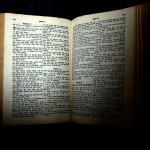A lengthy volume, just published, on the Book of Moses has got me thinking about the Joseph Smith Translation again. Going on five years now, I find it difficult to avoid the conclusion that there is no place for the Inspired Version in the study of the ancient world in general, textual criticism of the Bible in particular. If the JST is
to be studied academically, it is within the context of the nineteenth century. Such have been my tortured thoughts.
Of the various types of criticism of the Bible and other ancient literature, textual criticism is the most scientific, the least interpretive, the most elitist. It is the domain of the scholar’s scholar: introductions to many critical editions are written in Latin, even today. Based on available witnesses, through reconstruction of
fragmentary passages, and perhaps with recourse to the occasional emendation, the main objective of this type of criticism is to restore the text to read as it did when it left the author’s hand. Or as close to that as possible. Right?
In English, Romans 5:1 goes something like “Then because we have been justified by faith, we have peace with God through our Lord Jesus Christ.” Other manuscripts read “let us have,” a subjunctive instead of an indicative. The subjunctive occurs in all the major codices, etc., while the indicative was added to them by later scribes. Yet the Greek New Testament committee chose the indicative. Why?
Bruce Metzger explains is his textual commentary. Although the subjunctive “has far better external support,” the GNT committee decided to go with the indicative because “in this passage it appears that Paul is not exhorting but stating facts.” Variation between the two readings amounts orthographically to just one letter, an omega (long ‘o’) in the subjunctive and an omicron (short ‘o’) in the indicative. As he was dictating the epistle, Paul said “we have,” but his secretary, hearing an omega instead of an omicron, wrote “let us have.”
So at Romans 5:1 at least, the GNT does not represent the autograph. It goes beyond the original text to what the author ‘really’ meant/said. Is this at all similar to what Joseph Smith (thought he) was doing? How is it different? And is it a difference simply in degree or rather in kind? Of course, the GNT of Romans 5:1 is actually attested in late antique and medieval manuscripts. But even if it weren’t, I suspect that that the committee would have made the same decision.
To my knowledge, this is the only place in the GNT where the editors do such a thing expressly. Does anyone know of other places? And what of the Hebrew Bible?











